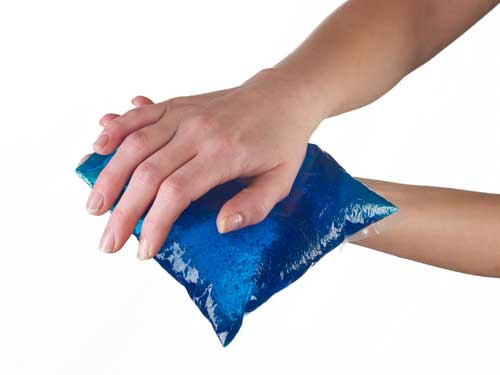What could be more inconvenient and uncomfortable than a fitness injury? In many cases, you can avoid them by using good form and not overtraining, but sometimes, despite your best efforts, you injure yourself or end up with a muscle strain. Of course, you want to do something to make your sore, aching muscles or tendons feel better. What’s your best choice? Heat or cold for fitness injuries?
Heat or Cold for Fitness Injuries:
Should you apply an ice pack or bring out the heating pad when you’re sore or injured? It depends. In general, an ice or cold pack has the most benefits within 2-3 days of an acute injury, especially if you have swelling. Ice constricts blood vessels and helps bring the swelling down.
Ice is also effective for relieving pain. Much of the initial pain you experience when you have a sprain or acute muscle strain comes from the rupture of tiny blood vessels called capillaries. When you apply ice to the area, it reduces blood vessel leakage. As long as the swelling persists, ice is your best option. Ice also has a mild numbing effect. This helps take the edge off of the pain.
If you’re using a freezer gel pack, be careful. They get cold enough to cause frostbite. Place a damp washcloth between the freezer pack and your skin. Remember RICE – rest, ice, compression, elevation? The combination of the four is better than ice alone. Place an ACE wrap over a freezer pack to hold it in place. The extra compression will further decrease pain and swelling. Elevation also reduces swelling, so try to keep the injured part above your heart.
Does ice speed healing? Ice seems to be most effective for reducing pain than for mending the damage. Despite the wide acceptance of ice as therapy for acute injuries, there’s no evidence that it speeds up healing. Some studies even suggest prolonged use of ice delays it. Just as some studies show non-steroidal anti-inflammatory medications slows healing by blocking inflammation, ice may have a similar effect. Inflammation is an important part of the repair process. Inflammation brings a variety of cells and proteins involved in healing and repair. When you constrict the blood vessels with ice, the “repair crew” has a harder time getting to the injury site.
Use ice only in the short term to relieve pain and swelling in combination with compression. Once the swelling is down, use compression without ice. Of the two, compression seems to offer greater benefits than ice.
Another word of warning – don’t ice a muscle or tendon before a workout. Ice reduces blood flow and the effects persist even after you’ve removed the ice pack. This decrease in blood flow may increase your risk of injury.
When Should You Use Heat For Fitness Injuries?
Once an injury is no longer acute, heat is a better choice. Heat is a good option for chronic or recurring muscle tightness and discomfort. Heat has the opposite effect of ice. It opens up blood vessels and increases blood flow to the area. It also helps relax tight muscles. You can use a heating pad but a moist heat source, like a hot water bottle or damp, heated towel, is better.
Another way to soothe sore muscles is to stand in a warm shower and let the water hit the painful area. You can apply heat several times a day to sore muscles but limit your sessions to no more than 15 minutes at a time. Never apply heat to a muscle or tendon that’s swollen. Heat expands blood vessels and can make the swelling worse.
Contrast Therapy
Some therapists use contrast therapy to reduce swelling. Contrast therapy means alternating heat and cold. For an injured muscle or tendon, you would apply cold to the area followed by heat in a 1 to 3 ratio: 1 minute of cold followed by 3 minutes of heat. Doing this constricts and dilates blood and lymph vessels. This creates a “pump” that helps the lymph vessels drain fluid and reduce swelling more quickly. At least that’s the theory.
There’s not a lot of evidence that contrast theory is better than using ice or heat alone and it’s not something you should use to treat swelling during the acute phase of injury. Stick with RICE during the first 48 to 72 hours. Contrast therapy may also be effective for relieving pain and stiffness due to a chronic injury. The contrast in temperature has a pain-reducing effect on fitness injuries.
The Bottom Line
For an acute injury where there’s swelling, compression is the best tactic — wrap the area in an ACE wrap. Ice may help with the pain and swelling but it can also interfere with healing if you use it inappropriately. Heat is helpful for chronic fitness injuries and tight muscles but not for an acute injury or an area that’s still swollen.
If you have a painful or persistent injury, you heard a “pop,” or can’t bear weight on a limb or move a body part, don’t try to treat it yourself. Seek medical attention. Do your best to prevent fitness injuries too by doing a good warm-up, using good form and not overtraining. Here’s to staying injury free!
References:
Am J Sport Med. 2004; 32:251-261.
Connizzo BK, Yannascoli SM, Tucker JJ, Caro AC, Riggin CN, Mauck RL, Soslowsky LJ, Steinberg DR, Bernstein J. The Detrimental Effects of Systemic Ibuprofen Delivery on Tendon Healing Are Time-Dependent. Clinical Orthopaedics and Related Research, 2013.
Human Kinetics. “How to Use Head and Cold to Treat Athletic Injuries” Excerpt from Therapeutic Modalities for Musculoskeletal Injuries, Third Edition.
Knee Surg Sports Traumatol Arthrosc. 2014 Feb 23.
Related Articles By Cathe:
5 Tips for Working with Heavy Weights


